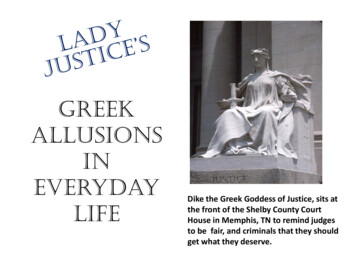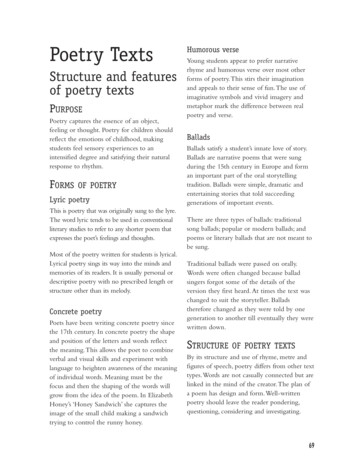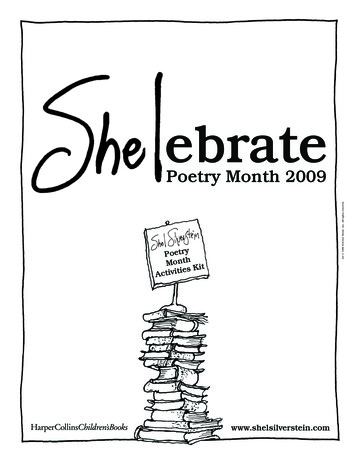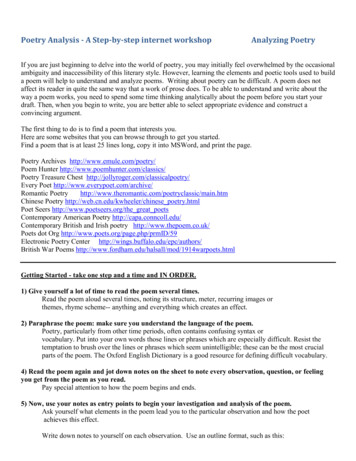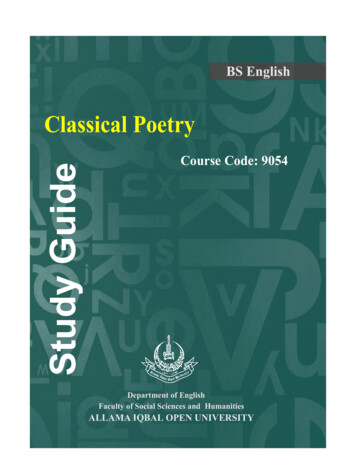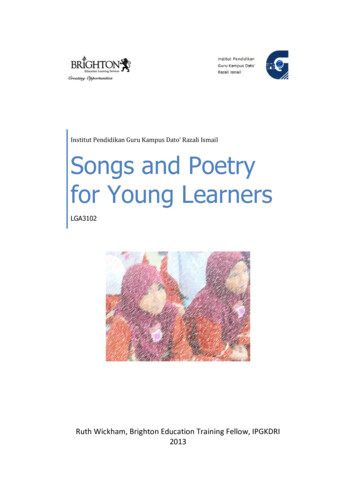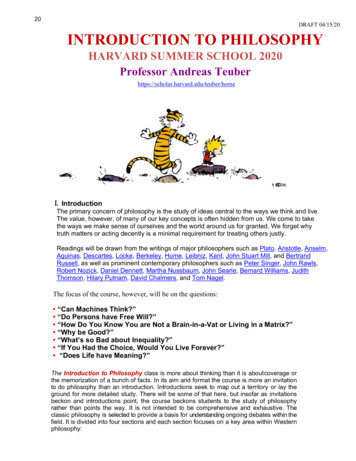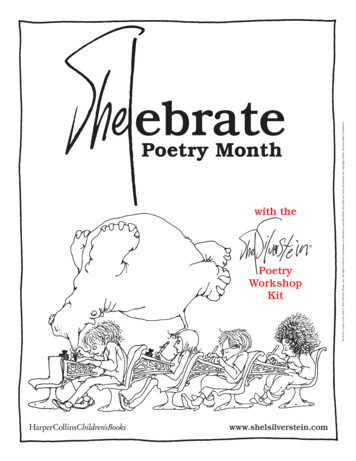
Transcription
ebratewith the PoetryWorkshopKitwww.shelsilverstein.comArt from A Light in the Attic 1981 Evil Eye Music, Inc. All rights reserved. Permission to reproduce and distribute this page has been granted by the copyright holder, HarperCollins Publishers.Poetry Month
Shel Silverstein Poetry Workshop KitIn celebration of Poetry Month, we’ve drawnupon poems from across Shel Silverstein’sclassic poetry books—Where the Sidewalk Ends,A Light in the Attic, Falling Up, and Every ThingOn It—to create a brand-new poetry experience.In this kit, children will learn about manydifferent types of poetry, gain clever tips towrite their own, and compile their own poetryportfolio, all while having some fun along theway. Perfect for use in the classroom, in abookstore, or at home, the Poetry WorkshopKit will give both children and adults renewedappreciation for poetry and the work ofShel Silverstein.So come in, open your imagination, bend your brain, andlet the magic of Shel Silverstein fill your mind thisPoetry Month!Enjoy hosting your ownShelebration event!www.shelsilverstein.comArt from Falling Up 1996 Evil Eye Music, LLC. All rights reserved. Permission to reproduce and distribute this page has been granted by the copyright holder, HarperCollins Publishers.Dear Reader,
Rhyming PoetryShel was an expert with rhyme, but how polished areYOUR skills? See how many rhyming words you canmake for each of the words in the list below and writethem in the space provided. After you brainstorm,choose one group of words and compose a rhymingpoem that would make Shel proud!CAKECATGREENSHOPSHARKY TIP!POETRtber thaRememsdrowesimtemosentk differolona.cl rhymebut stilReproducible ActivityMY RHYMING POEMwww.shelsilverstein.com“I Don’t Know” excerpt from Every Thing On It 2011 Evil Eye, LLC. Art from Falling Up 1996 Evil Eye Music, LLC. All rights reserved. Permission to reproduce and distribute this page has been granted by the copyright holder, HarperCollins Publishers.Rhyming poetry is one of the most common types of poetry—and sometimes themost fun! Rhymes can happen in many different patterns within a poem, suchas every line, every first and third line, or every second and fourth line. Most ofShel Silverstein’s poems use rhyme, and a great example is “I Don’t Know”from Every Thing On It. Read the excerpt below. What kind of rhyming patterndo you notice? How does Shel use repetition in this poem?
Epigram PoetryNow it’s your turn! Use your imagination to write another two-line epigram onthe lines below that continues the story of “Stone Airplane.” Then think oftwo additional epigrams about topics of your choice and add them to this page.Don’t forget to include illustrations!(continued)MY EPIGRAMSPOETRYTIP!Use an epigramto give funnyadvice or makean ironicstatement.Reproducible Activitywww.shelsilverstein.com“Stone Airplane” poem and art from Falling Up 1996 Evil Eye Music, LLC. Art from Where the Sidewalk Ends 1974, renewed 2002 Evil Eye, LLC. All rights reserved. Permission to reproduce and distribute this page has been granted by the copyright holder, HarperCollins Publishers.An epigram is a short and witty poem typically written as a couplet or a simpleone-line phrase. Shel often uses this succinct but powerful type of poetry,usually accompanied by art. Read “Stone Airplane” from Falling Up. How dothe words and illustration work together to create a humorous poem?
Visual poetry uses text, images, or symbols to help convey the meaning of thepoem. With this type of poetry, the visual arrangement of the elements ofthe poem is more important than the words in conveying its meaning.Read the poem “Lazy Jane” from Where the Sidewalk Ends. How is the way thepoem is displayed on the page key to the meaning of poem? Would the poembe as funny without the illustration? Why or why not?Come up with a new way to depict the poem in the box to the right,with either an illustration or a clever arrangement of the text. Does yourdrawing or arrangement change its meaning? How?LAZY JANEY TIP!POETR heUse tations indescrip a guidespoem a u decideoyitwhendisplayothow.epagon theReproducible Activitywww.shelsilverstein.com“Lazy Jane” poem and art from Where the Sidewalk Ends 1974, renewed 2002 Evil Eye, LLC. Art from Falling Up 1996 Evil Eye Music, LLC. All rights reserved. Permission to reproduce and distribute this page has been granted by the copyright holder, HarperCollins Publishers.Visual Poetry
Concrete poetry (also called shape poetry) is similar to visual poetry, but instead ofusing visual clues to reinforce meaning, it uses the actual arrangement of the wordsin a shape or other design to convey the subject or idea of the poem. For example,read “Circle Road” from Every Thing On It below. You’ll notice that the poem itself isdisplayed as a circle. How does this placement help you better understand the poem?Would the poem make sense if it was displayed as a square?Try your hand at a concrete poem! Write about something you know (and can draw),such as a favorite food or sport. Using a pencil, in the space below sketch an outlineof your object as a guide when writing. Then compose your poem in the space of thedrawing. When your poem is complete, erase the outline—yourpoem should represent the thing you are writing about! Add extraPOETRY TIP!details in or around the poem the way Shel does in “Circle Road”Use descriptiveto help convey its meaning.words in yourpoem withoutmentioning whatyou are writingabout—yourdrawing shouldwork with thetext to tell thereader its topic.Reproducible Activitywww.shelsilverstein.com“Circle Road” poem and art from Every Thing On It 2011 Evil Eye, LLC. Art from Where the Sidewalk Ends 1974, renewed 2002 Evil Eye, LLC. All rights reserved. Permission to reproduce and distribute this page has been granted by the copyright holder, HarperCollins Publishers.Concrete Poetry
List PoetryList poetry is comprised of a list of things, places, people, or events, and it canbe any length, rhymed or unrhymed. Take a look at “A Closet Full of Shoes” fromFalling Up below—Shel takes an ordinary list of items (in his case, shoes) and makesit extraordinary by adding humor, rhymes, descriptive words, and even illustrations.What other types of lists would make funny poems?A Store Full of FoodY TIP!POETR ilitiesssibThe po ss whenledare en st poems,ligwritin ake surebut m ms areeyour it ted inlaerallay.some wReproducible Activitywww.shelsilverstein.comArt from Falling Up 1996 Evil Eye Music, Inc. All rights reserved. Permission to reproduce and distribute this page has been granted by the copyright holder, HarperCollins Publishers.On a piece of scrap paper, write ten items that would be on your family’s grocery list,such as apples, bread, or eggs. Then in the space to the right, turn your list into apoem. Using the words you wrote, describe the items you see in the grocery store,being as silly and creative as you can. Read your finished poem the next time yougo food shopping with your family—you won’t forget a thing!
A rebus is a poem that uses pictures or symbols in place of actual words. Rebusesare helpful (and clever!) ways to build reading and writing skills and incorporate artinto a poem. In “Deaf Donald” from A Light in the Attic, Shel uses a drawing in placeof an idea to create a humorous story about a boy who can’t hear or speak.How does the drawing lend meaning to the poem?Turn the poem below from A Light in the Attic into a rebus! Use the list of wordsabove the poem to fill in the blanks, but draw a picture in place of the actual word.(Hint: the words that rhyme go together—except for one!)LOGBEESWATTERSNAKEPIGFEATHERHITTINGUse ato hit a hog.Use a twig to hit a.Use a rake to hit a.Use aUse a ski to hit aAnd use aReproducible Activityto hit an otter.when you hit me.POETRY TIP!Try writing arebus usingall pictures.Then challengea friend totranslate yourpoem intowords.www.shelsilverstein.com“Hitting” poem from A Light in the Attic 1981 Evil Eye Music, Inc. Art from Where the Sidewalk Ends 1974, renewed 2002 Evil Eye, LLC; Falling Up 1996 Evil Eye Music, LLC. All rights reserved. Permission to reproduce and distribute this page has been granted by the copyright holder, HarperCollins Publishers.Rebus Poetry
Non-Rhyming PoetryAre YOU up to the no-rhyme challenge?Compose a poem about yourself in the style of “Tell Me,”filling in the blanks below. Remember that rhyming words don’t count!POETRYTIP!Be creative—employ other tactics,such as repetition oralliteration, to makeyour poemunique withoutrhyme.Tell me I’m,Tell me I’m,Tell me I’m,Tell me I’m,Tell me I’m,andReproducible Activity,Tell me I’m—But tell me.www.shelsilverstein.com“Tell Me” poem and art from Falling Up 1996 Evil Eye Music, LLC. Art from Where the Sidewalk Ends 1974, renewed 2002 Evil Eye, LLC. All rights reserved. Permission to reproduce and distribute this page has been granted by the copyright holder, HarperCollins Publishers.Did you know that a poem doesn’t have to rhyme? Non-rhyming poetry focuses moreon the other elements that make up a poem, such as pattern, rhythm, creativity, andtone. Read “Tell Me” from Falling Up. What kind of beat do you notice when you readthe poem aloud? What factors make “Tell Me” a poem even though it doesn’t rhyme?
Acrostic PoetryShel was a talented writerHis work is admired by manyEvery poem is so cleverLet’s go read them togetherIn the box below, write an acrostic poem about a friend, family member, or teacher.Your poem can be full sentences or simply a couple of words about your topic.When you finish writing, color and decorate your poem and ask a grown-up to helpyou cut it out from the page. Give it to the person you wrote about as a gift!Y TIP!POETR ent takeeiff rFor a d style, writeon this that usesa poem letter of atthe firs the middlemorfthewordline of thehcaefoouto spellpoem t ’s topic.poemReproducible Activitywww.shelsilverstein.comArt from Where the Sidewalk Ends 1974, renewed 2002 Evil Eye, LLC; Falling Up 1996 Evil Eye Music, LLC. All rights reserved. Permission to reproduce and distribute this page has been granted by the copyright holder, HarperCollins Publishers.An acrostic poem uses the letters of a word or name to begineach line of the poem, and each line must in turn relate to theword. Anything goes when it comes to acrostics, and they’re afun way to add a personal touch to a poem. Study our originalexample below, which uses Shel as a subject,and then create your own acrostic masterpiece!
classic poetry books—Where the Sidewalk Ends, A Light in the Attic, Falling Up, and Every Thing On It—to create a brand-new poetry experience. In this kit, children will learn about many different types of poetry, gain clever tips to write their own, and compile their own poetry portfolio, all while having some fun along the way.
